|
|
|
I had an
opportunity to use a 16 Megapixel Kodak DCS Pro
Back 645M for a couple of weeks and found the
medium format Mamiya 645AFD based camera to be
surprisingly easy to handle and
operate. The DCS
Pro Back 645AFD's controls and digital
system are consistent with a typical
pro-style digital camera, so the
learning curve is relatively simple.
Existing
Kodak Pro camera users will feel right
at home the instant they turn the
camera on. The digital operating
systems and menus are nearly identical
to those found on the popular 300, 400,
500, 600, and 700 series digital SLR
cameras. The
Digital Back The
digital back uses a separate single
slide & snap-in rechargeable
battery (shown at left), about half
the size of a traditional Kodak DCS
series battery like the DCS 520,
620, 620x, 560, 660, 720x, or 760
uses. The battery snaps and locks
positively and securely in place on
the bottom of the Pro Back.
Among
the best I've ever seen except for
one minor glitch. Foliage greens
(grass, trees,etc.) straight out of
the camera frequently have a slight
blue-green look, but it's easily
corrected with a one-step 20% to 40%
reduction in the cyan field in the
greens (only) under selective color
adjustment (Adobe
Photoshop). The
screenshot at right shows the simple
correction procedure. Try 20% first,
use up to 40% in extreme
cases. Again,
skin tones (all kinds) are extremely
accurate and
lifelike.
The Camera
Body The
Mamiya 645AFD camera body is a
cross-platform system that is
specifically engineered to include
digital backs. It's
lightweight, comfortable to handle, and
operates like a traditional 35mm SLR
camera. In
addition to the Kodak Pro Back, the
camera can be easily fitted with
quick-change film magazines for 120,
220 or Polaroid film. 35mm
F3.5 80mm
f2.8 300mm
f4.5 120mm
Macro (P)
Program AE Mode Automatically
determines optimal exposure
settings, using pre-programmed
aperture and shutter values to
ensure exposure accuracy under
ambient lighting. Digital
dial-controlled program shift
enables adjustment of shutter speeds
and aperture in 1 EV steps from (P)
mode. (PH)
favors faster shutter speeds and
larger apertures. This is ideal for
moving subjects or shallow
depth-of-field used in many
portraits. (PL)
favors slower shutter speeds and
smaller apertures. This is ideal for
landscape where control of
depth-of-field is needed. These
settings provide a versatile
response to most shooting
conditions. This mode is ideal for
general photography without the need
to make adjustments. (Av)
Aperture Priority Adjust
the aperture value with the digital
dial to the appropriate setting, and
the camera automatically adjusts
shutter speed to match. Aperture
values can be set in 1/2
stops. (Tv)
Shutter Speed Set
the desired shutter speed via the
digital dial and the camera
automatically adjusts aperture value
to match. Shutter values can be set
in 1/2 steps. (M)
Manual Mode Used
to adjust settings based on readings
from an exposure meter. The rear
dial adjusts aperture value while
shutter speed is set using the front
dial. Both values can be set in 1/2
steps. The photographer can put half
pressure on the shutter release to
view the difference between set
values and values metered by the
camera and displayed in the
viewfinder LCD. The difference
indications disappear from the LCD
panel when set values match metered
values. (X)
Flash Synch Mode Fixes
shutter speed at the sync speed of
1/125 sec while allowing adjustment
of the aperture setting. In this
position, the exposure dial locks
and cannot be rotated. Perfect for
easy flash operation. (T)
Time Exposure Mode Mechanically
controlled mode for long
exposures. (A)
5-Segment Evaluative Average
Metering Meters
the average brightness of the entire
image, with emphasis on the center
of the screen. The four outer
segments plus spot area are
measured, the brightest of the outer
four eliminated and the remaining
three plus spot are averaged
together for remarkable results is
challenging lighting
situations. (S)
Spot Metering Meters
reflected light on the image at a
specific point, indicated by the
circle at the center of the viewing
screen. It is optimal for use with
high contrast subjects and for
measuring brightness at a specific
area of the subject. The angle of
acceptance changes according to the
focal length of the lens
attached. (AUTO
A-S) Variable Automatically
switches between 5-Segment
Evaluative Average and Spot modes
depending on the relative contrast
within the overall image; it
provides exposure settings suited to
a wide range of subjects and
lighting conditions.
Sample
Pictures Indoor
available light snapshot taken under
difficult mixed lighting conditions -
overhead fluorescents & indirect
sunlight. Original
image size reduced for web
viewing. Midday,
strong overhead sunlight mixed with
deep shadows. Great example of the
dynamic range of the Pro Back 645M.
This is
the first (ever) camera that got the
orange color in her T-shirt "just
right". Original
image size reduced for web
viewing. Late
afternoon, strong shadows, direct sun
against white fur. Good
job not blowing out the
highlights, good shadow
detail. Original
image size reduced for web
viewing.
Kodak
Photo Desk Do your raw
picture conversion with Kodak's Photo Desk
software, then save it as a Tiff & send it
to Adobe Photoshop. It's free, it's fast, it's
clean, it's simple, and it's
straightforward.
Does the Kodak Pro Back
have a "multiplier
factor"? Yes. The Pro
Back 645M has a larger available film capture
area than the digital back's 36mm square sensor,
so there is indeed a multiplier factor for Pro
Back users compared to the angle of view they
get using a traditional film back. The multiplier
factor compared to 645 film is approximately
1.5x with any given lens when the DCS Pro Back
is installed. That's because a 645 film frame
measures 56mm wide. Divide the film frame width
by the digital sensor width and you'll have the
multiplier factor. 56mm (645 film width) divided
by 36mm (CCD sensor width) equals 1.5555 (I
rounded it down to 1.5). The Pro Back's
sensor measures 36mm x 36mm (the same width as a
35mm film frame), therefore the captured picture
has the same horizontal angle of view as a 35mm
film camera. So if you think in terms of what
you see using traditional 35mm film cameras and
lenses, you'll feel right at home. And if you
like the 35mm aspect ratio, it's really great,
because you can crop the square picture
horizontally or vertically to a traditional 35mm
film 2:3 aspect ratio without having to turn the
camera on its side. Here's some
confusing fun with multipliers...
Conclusion |





.jpg)
.jpg)
.jpg)
